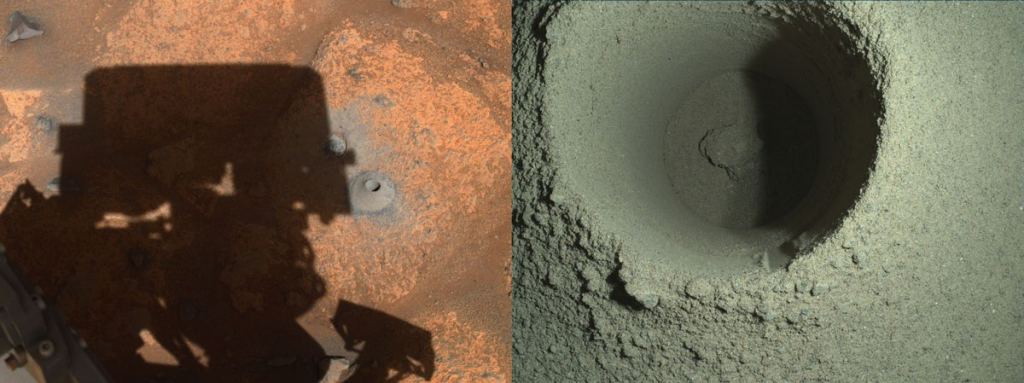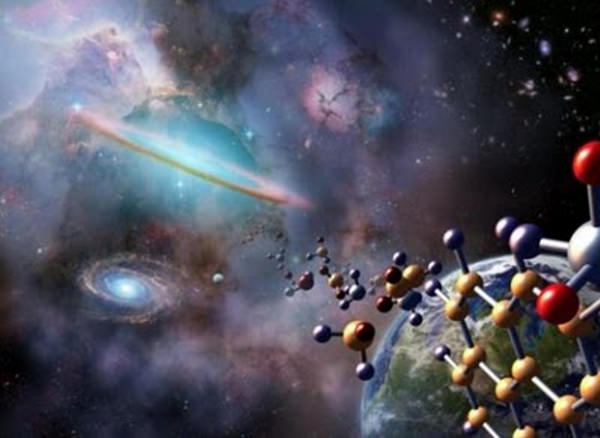A few years from now, a small capsule will enter Earth's atmosphere and float to the surface under a parachute. The parachute will likely be radar-reflective so that it can be easily tracked. It may land in Australia's outback, a popular spot for sample returns. Scientists will take it to a sterilized, secure lab and carefully open it. Inside, there'll be rock samples from Mars collected by the Perseverance Rover.
If a new study is correct, scientists should look carefully for dormant life in those samples.
Perseverance was sent to the Jezero Crater on Mars to look for evidence of ancient microbial life. As part of its mission, it collects samples and caches them. In the future, a joint ESA/NASA mission will retrieve those samples and send them back to Earth.
But if the new research proves correct, this scenario will have a twist. Rather than fossilized evidence of ancient life, the samples could contain dormant bacteria.
The study is " Effects of Desiccation and Freezing on Microbial Ionizing Radiation Survivability: Considerations for Mars Sample Return. " It's published in the journal Astrobiology. The lead author is Michael Daly, a professor of pathology at Uniformed Services University of the Health Sciences (USU).
The Perseverance Rover can't dig very deep. But it won't need to if the study is correct. While Mars isn't likely to host any active life, the research shows that dormant bacteria could survive close to the surface for hundreds of millions of years.
Mars is dry, frigid, and bleak, even though images from Perseverance and Curiosity show the planet's intriguing, even beautiful side. With our current knowledge of life and its needs, we can safely conclude that it's a dead planet. But Mars was almost certainly a warmer, wetter place in the past, and conditions were favourable for life. Or at least simple life.
As scientists learn more about extremophiles on Earth, it raises the possibility of extremophiles on Mars. Extremophiles are important because they're like a bookend for life. They show how extreme an environment can be and still support life as we know it. Since Mars is such an extreme place, there's a crossover.
"There is no flowing water or significant water in the Martian atmosphere, so cells and spores would dry out," said Northwestern University's Brian Hoffman, one of the paper's senior authors. "It also is known that the surface temperature on Mars is roughly similar to dry ice, so it is indeed deeply frozen."
The ionizing radiation on Mars' surface also constitutes an extreme. No atmosphere or magnetic shield protects the surface from a bombardment of cosmic radiation and solar protons. The freezing temperatures and lack of water are also extreme. The researchers simulated these conditions to see if life could survive.
The first step was to determine how much ionizing radiation it takes to kill microbial life. Then they chose six types of Earth bacteria and fungi and exposed them to radiation in a simulated cold, dry, Martian environment. They varied the amount of radiation to simulate different depths. The deeper an organism is buried, the more protected it is from radiation.
The researchers used manganese antioxidants as a tracer for radiation exposure. An advanced spectroscopy technique measured the buildup of antioxidants in the organisms' cells. There's a correlation between antioxidant buildup and how much radiation an organism or its spore can withstand. More manganese antioxidants mean an organism can withstand more radiation and survive in harsh conditions.
One organism, named Deinococcus radiodurans, is one of the most radiation-resistant organisms scientists know of. It's not only an extremophile but also a polyextremophile because it can withstand multiple environmental extremes. D. radiodurans can withstand extreme cold, radiation, acidity, dehydration, and vacuum. Scientists nicknamed it Conan the Bacterium.
"It's a very, very ancient organism that has been around presumably for billions of years. In the long, long history of Earth, there have never been levels of ionizing radiation that approach the levels that these and other bacteria can survive." Michael Daly, lead author, Uniformed Services University of the Health Sciences.
In an interview with Universe Today*, the lead author Michael Daly described Conan the Bacterium, which he's been working with for 30 years. "The name is Deinococcus radiodurans. The Greek and Latin roots mean 'strange or terrible radiation resistant berry.' It's most famous for its extreme resistance to both the lethal and mutagenic effects of ionizing radiation. That's x-rays, gamma rays, galactic cosmic radiation, and solar protons."
D. radiodurans was first discovered in 1956 as part of research into sterilizing canned food with gamma irradiation. During experiments, researchers found the meat in the cans was spoiled even after exposing them to Cobalt 60. The culprit was D. radiodurans, which were able to withstand the radiation.
"It's a very, very ancient organism that has been around presumably for billions of years," Daly told Universe Today. "In the long, long history of Earth, there have never been levels of ionizing radiation that approach the levels that these and other bacteria can survive."
Why can an organism withstand so much radiation when it's never had to?
"Desiccation causes very similar damage to radiation," Daly told Universe Today. "Desiccation will break DNA, but ionizing radiation and desiccation also damage all the machinery required to put DNA back together again." But D. radiodurans has evolved a way of protecting its DNA-repairing ability. The bacteria contain multiple copies of their genome, which means they always have a blueprint for repairing their DNA. Though desiccation drove that evolution, the same repair mechanism works for radiation damage.
Previous research into Conan the Bacterium showed it could withstand 1.2 million years of Martian radiation if suspended in water. This research only bolsters Conan's reputation. The researchers found that dried, frozen D. radiodurans can withstand 1.5 million years of Martian surface radiation when buried only 10 centimetres (4 inches) below the surface. And if it's buried even deeper, 10 meters (33 feet,) it can survive for a staggering 280 million years.
This is a shocking finding. But the only problem is that Mars has been cold, dry, and irradiated for much longer. Mars was warm and wet about 2 to 2.5 billion years ago and has been inhospitable since. Could Conan the Bacterium or a similar Martian bacterium survive that long somehow?
Possibly, say the paper's authors.
"Although D. radiodurans buried in the Martian subsurface could not survive dormant for the estimated 2 to 2.5 billion years since flowing water disappeared on Mars, such Martian environments are regularly altered and melted by meteorite impacts," lead author Daly said in a press release. "We suggest that periodic melting could allow intermittent repopulation and dispersal."
Even if hardy, dormant life hasn't survived until today, their hardiness means they've likely left evidence of their existence. "Also, if Martian life ever existed, even if viable lifeforms are not now present on Mars, their macromolecules and viruses would survive much, much longer," Daly said. "That strengthens the probability that, if life ever evolved on Mars, this will be revealed in future missions."
What does this mean for the samples that'll be returned to Earth? Perseverance can only get a few centimetres into the regolith for its samples. The first few centimetres don't provide much protection. When solar protons slam into the regolith, they produce coincidental gamma radiation. This radiation makes the top few centimetres the most dangerous radiation environment, and the paper shows that D. radiodurans is unlikely to survive beyond 1.5 million years at that depth. So the possibility of Perseverance samples containing D. radiodurans might be low, but it's real.
But future rovers will collect samples from much deeper. The Rosalind Franklin rover will collect samples from as deep as 2 metres (6 ft 7 in) below Mars' surface. Rosalind Franklin isn't a sample return mission, but future rovers that can reach the same depth will be. That raises the stakes when it comes to the risk of contaminating Earth.
When it comes to Mars, the deeper we go, the greater the possibility that we find dormant life or even active life. Earth shelters life kilometres below the surface. Could the same be true for Mars?
"The preconditions for life probably existed on Mars before they existed on Earth. As conditions deteriorated on the surface, life probably escaped down beneath the surface or in lava caves, somewhere with durable protection," Daly told Universe Today. "We have life very deep here on Earth, miles down. There's plenty of life down there. There's no reason in my mind to think that if there ever was life on Mars that it wouldn't still be there, deep below the surface."
Those depths are beyond our reach for the foreseeable future. The question is, could it be near the surface? "Our work suggests that that's a distinct possibility. Although everything's been frozen for billions of years, there are opportunities for recovery during meteorite impacts," Daly told Universe Today.
Mars is covered in impact craters, and each impact generates heat that melts ice into water. Impacts churn up the surface, and impact sites can stay warm for a long time. This could allow these organisms to recover.
"Our model organisms serve as proxies for both forward contamination of Mars, as well as backward contamination of Earth, both of which should be avoided," said Daly, who not only led the study but is also a member of the National Academies' Committee on Planetary Protection.
"We concluded that terrestrial contamination on Mars would essentially be permanent — over timeframes of thousands of years," said co-author Hoffman. "This could complicate scientific efforts to look for Martian life. Likewise, if microbes evolved on Mars, they could be capable of surviving until the present day. That means returning Mars samples could contaminate Earth."
Or did Martian life already contaminate Earth?
One hypothesis is that simple life developed on Mars first and hitched a ride to Earth on a meteorite. That's called panspermia.
"It's not unreasonable that panspermia could happen," Daly told Universe Today. But there are a bunch of caveats. Organisms would have to be hardy enough to survive the radiation, the desiccation, the cold, and the vacuum. But rocks tumble through space, and the sunny side heats up. So any life would need to survive the heat, too.
They'd also need to survive re-entry.
Daly cautions that he's not an expert on atmospheric re-entry. "There are certainly examples of rocks from the heavens that reach Earth's surface, and they're still frozen," he suggested.
As meteors travel through the atmosphere and heat up due to friction, ablation removes the outer layer of material. Ablation is a very efficient heat-removal mechanism, so some rocks could be cool when they land. If they're big enough, could the inside still be frozen?
In a 2001 NASA article, Donald Yeomans, manager of NASA's Near Earth Object program at the Jet Propulsion Laboratory, said, "Rocky asteroids are poor conductors of heat. Their central regions remain cool even as the hot outer layers are ablated away."
Life in the Solar System is a puzzle. Where and when it originated, how it might've spread through space, and where it might be clinging to existence are still open questions, though scientists have made enormous progress in their understanding.
We'll likely wait a long time before we have any definitive understanding of life, how it spreads, and how long it can survive in different environments. But this study shows how persistent some life can be, handling everything an extreme environment can throw at it.
But if scientists find a dormant Martian lifeform similar to D. radiodurans in the Perseverance samples, one huge piece of the puzzle will be in place.
*Professor Daly's remarks were edited for clarity and brevity.
 Universe Today
Universe Today







